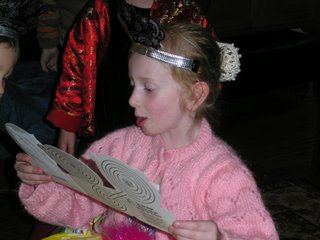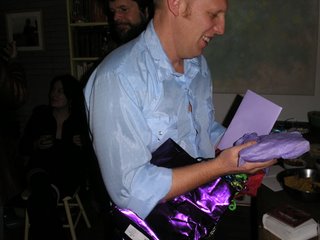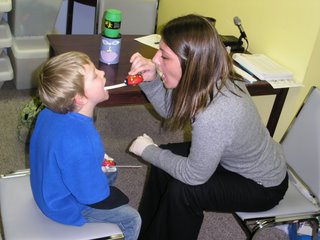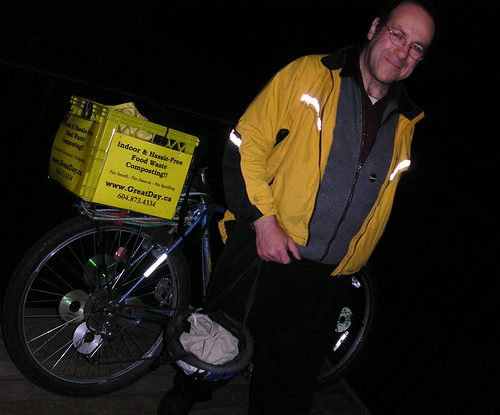Visiting the artists at the Eastside Culture Crawl
No special lenses, no flash, no darkroom tricks, no cropping, and no computers were used in the eight “Sensitive Images” that photographer Kelley Montgomery exhibited at the Eastside Culture Crawl in the Kettle Friendship Society.
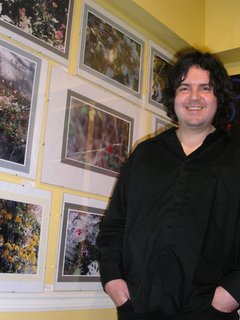
It's refreshing to see this lack of artifice in our age of digital image manipulation - where we can "photoshop" things into cold perfection, limited by nothing more than the bounds of imagination. This fact is what made Kelley’s photos seem so charmingly “honest” to me – these luscious close-ups of vibrant greenery and flowery sprinklings of yellow, pink, and red in the gardens of the Riverview Mental Hospital. My favorite photo showed a perfect little red rose as a focal point surrounded by a softly focused patch of green.
I read the title of the photos aloud: “Sensitive Images. Hmmm… sensitive in what way?”
Kelley said he chose the title because he liked its sound and hadn’t put much thought into it. Then he paused and looked thoughtful, adding: “It’s about the sensitivity needed to capture something in nature – to align yourself with something in nature.”
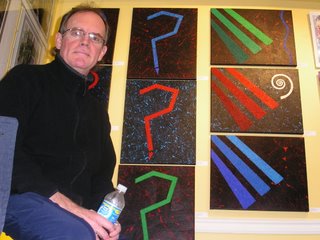
Next to Kelley’s photos were paintings by Martin Murphy, who not only offered his art for our viewing pleasure, but also spent about 10 hours helping to hang all the art at the Kettle gallery.
“I learned a lot about hanging a show – that’s for sure,” Martin said. “It’s definitely something I enjoyed doing. It was an eye-opener for sure on how a show goes together.”
Martin says in his artist’s statement: “My art is a trial and error process in color, form and symbol. These are used to create unique paintings using color combined with ancient and modern symbols… ? is very similar to an Egyptian hieroglyphic symbol. What does it mean?”
I read this statement aloud, paused, and looked at the question marks – of which some are male and some female, he explained. “Well, what does it mean?” I asked, wondering if the question mark as we use it has somehow evolved from the hieroglyph.
“I don’t know,” he said, with a smile and a shrug.
“Oh…Well maybe some Egyptology expert will show up and tell you,” I joked.
Kelley and Martin are among 300 artists who welcomed the public to their studios and warehouses in 43 locations between First Avenue and the waterfront, from Main Street to Commercial Drive. Some of the more interesting location names... Mergatroid, Hungry Thumbs, artrescue, Alley Gallery, the Yellow House Studio.
Now in its 10th year, this annual event included dancers, furniture makers, glassblowers, jewelers, musicians, painters, photographers, potters, sculptors, weavers, and writers. Some are emerging artists, while others are veterans on the scene. My son and I went to four of the venues, all of which were bustling with visitors. It looked like a good turn-out, with a steady stream of scarf and toque-clad people tip-toeing through our early snow from one studio to another.
The generous folks of Kroma Artist’s Acrylics at 1000 Parker St. opened their warehouse space, and laid out tubes of their hand-made acrylic paints for people to use. I asked Kroma’s Hannah Bennett if they were selling much paint.
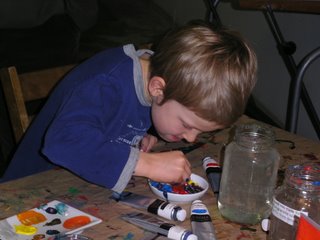
“Yes,” she said. “But mostly the focus is to just get people in to push the paint around and have fun. We did it last year and it was a really, really great success so we thought we’d do it again.”
Toby and I took a seat at the table elbow-to-elbow with the other painters filling up the 3 X 5-inch wood blocks with colour. One young, heavily tattooed man worked away at a lovely, multi-coloured sunset on the water, while his companion brushed a dark cedar silhouette atop a misty turquoise forest. I noticed a woman, deep in concentration, who laughed and apologized when she accidentally dipped her paint brush into someone else’s tea. This set off a little discussion about how scientists are never allowed to take drinks into laboratories…
As I flicked and scraped and swooshed the vibrant colours, a quirky abstract image evolved before my eyes and I tried to decide if it was a set of happy lungs or a hyperactive bird warming up its wings for flight. What fun it was – this brief time a group of strangers sat together and shared the experience of playing with paint.
It was interesting to see something resembling terror on a few of the faces of people who declined the opportunity to paint. “Oh no! I am definitely not an artist!” one woman said, backing away from the table with a spark of fear in her eyes. But it really wasn’t about “being good at it” – it was more like being in elementary school and having fun, playing, seeing how cool and fun and exciting it is to slosh the colours together. It seemed sad to think of people being too scared to enjoy the experience because they thought they would “fail” – worried that someone will look at their picture and snicker meanly…
But I digress! Ultimately I am very thankful for the generosity of these artists and volunteers who made this event happen. For more information, visit: http://www.eastsideculturecrawl.com
Technorati tags
art
community
Vancouver
culture
community arts
galleries
art exhibitions
